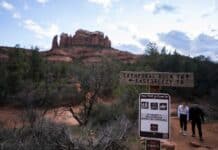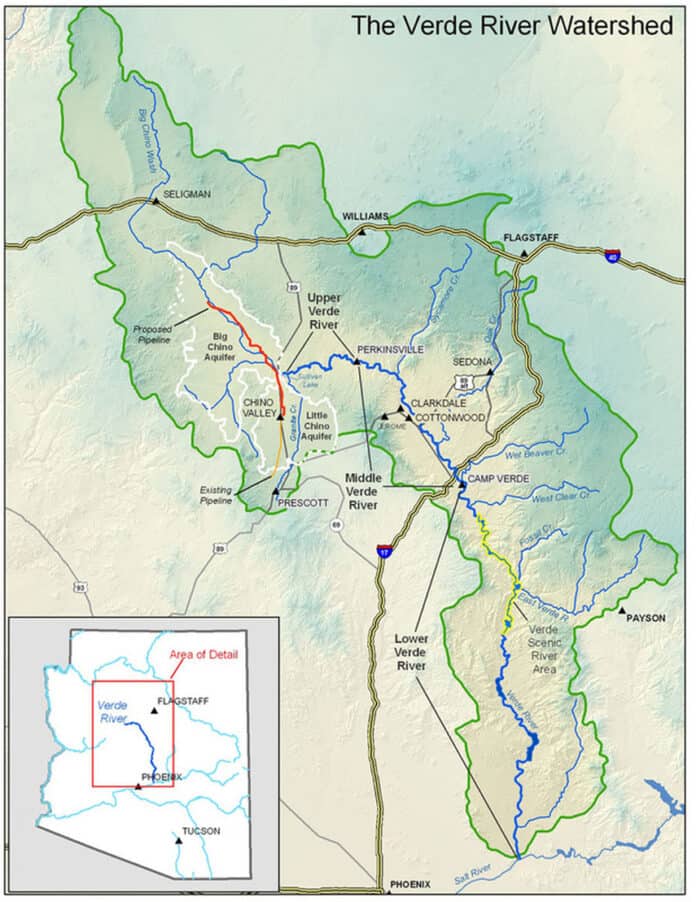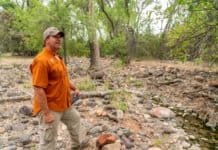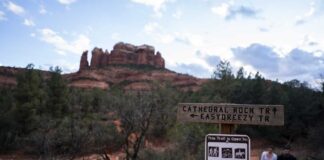Gary Beverly, a board member of the Citizens Water Advocacy Group and chairman of the Yavapai chapter of the Sierra Club, gave a Zoom presentation on Saturday, Oct. 14, on the proposed Big Chino Pipeline that would import water into the Prescott area from the Big Chino Valley to support regional growth.
Prescott Water Plans
The Big Chino Water Ranch is a partnership between the city of Prescott and the town of Prescott Valley for a “future water supply,” the city of Prescott stated on its website. Located 18 miles northwest of Paulden, it consists of over 6,530 acres of land located in the Big Chino sub-basin of the Verde River watershed that the city acquired in 2004.
On July 11, the Prescott city council unanimously approved $161,000 in engineering contracts in order to update the cost and feasibility estimates for the project.
“[Prescott] has a legal right to this water. There isn’t a political will to access it at this point, but we need to make sure we keep that right to access it. This will be a many-year project,” the minutes for the meeting stated, adding that there is no timeline for construction at present.
“My concern is this project was put on hold 13 years ago,” Councilman Eric Moore said during the meeting. “We’re going to spend $160,000 between these two contracts to get an updated price and then we might not move forward with this project for 10 more years and we’re gonna have to get an updated price again, because the prices that we get for this report will be of no value to us if and when the time actually comes up that we’re going to proceed with the project.”
The proposed pipeline is designed to move up to 3.9 billion gallons of water to the Prescott region annually.
“Many scientific studies by the United States Geological Survey have shown that groundwater pumping will remove water that would otherwise flow to the river; the baseflow would be reduced by an amount equivalent to the quantity pumped,” the CWAG stated in a policy position paper. Base flow is the amount of groundwater moving into a river system. “Reduced base flow is also predicted to damage the Verde River’s value as a sport fishery, with higher water temperatures, lower dissolved oxygen content and reduced visibility affecting the abundance, size and catchability of sport fish.”
USGS Analysis
Baseflows of rivers in the American Southwest are projected to decrease over this century making their management all the more critical.
The U.S. Geological Survey projected in an October 2022 study that the amount of base flow entering the Colorado River, which is a water source for 40 million users, may decrease by 33% by the 2080s and is projected to decline by 3% over the remainder of this century even under ideal wet conditions.
“Baseflow is what’s really, really important,” Beverly said. “That’s what keeps the river flowing 24/7. That’s what the riparian environment and all the fish and the wildlife depend on. So the base flow that comes from the groundwater is the key thing to maintaining the fall in the river … But also [I] want to point out that the baseflow [of the Verde River] is now down to 13 cubic feet per second. In 1978 it was 20, now it’s 13. This is a matter of deep concern.”
The Big Chino Water Ranch is legally authorized to import up to 12,000 acre-feet per year, an amount that exceeds the current flow of the Verde River, Beverly wrote in his presentation.
Conservationists are concerned that BCWR would threaten the river’s perennial flow, as the Big Chino aquifer is the source of over 80% of the Upper Verde River’s base flow and the project would ultimately reduce that contribution.
“The combination of climate change and groundwater pumping is an existential threat for this river,” Beverly said.
Public Lands
“We’ve actually had reasonable success [in] dealing with when cattle get into the river from the neighboring grazing pastures on Prescott National Forest,” Beverly said. “[Which] has improved the monitoring and this issue is much better, and we’re really appreciative to Prescott forest for stepping up to protect the river. Grazing is one of the most damaging things that is possible to a riparian environment.”
The MOU was approved by cattle industry groups and the federal government in late July, partly with the intent to increase allotment sizes, which had been cut in response to drought. However the short-term conditions of the rangeland have improved. “The range looks great right now,” University of Arizona rangeland manager George Ruyle said in late May. “We’ve had two good summers in a row, and then a good winter.”
“When I researched [the MOU], [I] decided not to oppose it,” Beverly said. “[Because] the MOU doesn’t alter the Forest [Service’s] responsibility and authority to manage these grazing permit landscapes. The new staff that’s hired to help do data collection on those allotments is trained by the Forest Service and supervised by them … The ranchers are thinking that this is going to get them their allotments restored more quickly; it might also get them restricted more quickly the next time the drought kicks up. We’re going to see how this works out. The ranchers might be surprised.”
Solutions
“After all this depressing stuff,” Beverly said, “stewardship is the solution. One solution is the Verde River Protection Act, CWAG is preparing a proposal now. It’s out for legal review. That would define mitigation, put the mitigation requirement into state water law. Right now the mitigation is just an agreement between Prescott, Prescott Valley and SRP. It’s not part of state law. It would require mitigation for all groundwater exports from the Big Chino and it would require [Arizona Department of Water Resources] approval of the mitigation plan and annual reporting.”
Beverly also mentioned the discussion about the creation of a Verde Headwaters State Park as another example of stewardship, but he noted that it has “no direct effect on water,” although it does increase awareness of the “importance of protecting the river.”
“For the park at the headwaters of the Verde River, we currently do not own any property,” Arizona State Parks public information officer Michelle Thompson said. “The Trust for Public Land is the organization that advocated for the park. They are going through development ideas with a landscape architect. At this time, we do not have a contract with TPL for this purchase. TPL will work with the land owner on the appraisal and purchase, then contract with Arizona State Parks and Trails to sell the land to us. At this time, the details for the acquisition and transfer have not been finalized.”
Another solution Beverly mentioned was conservation easements that allow landowners to sell developmental rights for land to groups such as the Nature Conservancy to preserve open space and to help prevent an increase in water demand.
Beverly is also optimistic that legislation will be introduced in March to designate the Upper Verde River as a Wild and Scenic River.
“[While] the Verde River watershed comprises only 5.8% of the land area in Arizona, it contains the best remaining riparian areas — lush, green ribbons full of life,” Beverly wrote in 2021. “The Verde supports a surprisingly large fraction of Arizona’s vertebrate species: 78% of breeding bird species, 89% of bat and carnivore species, 83% of native ungulate species and 76% of reptiles and amphibian genera.”






















